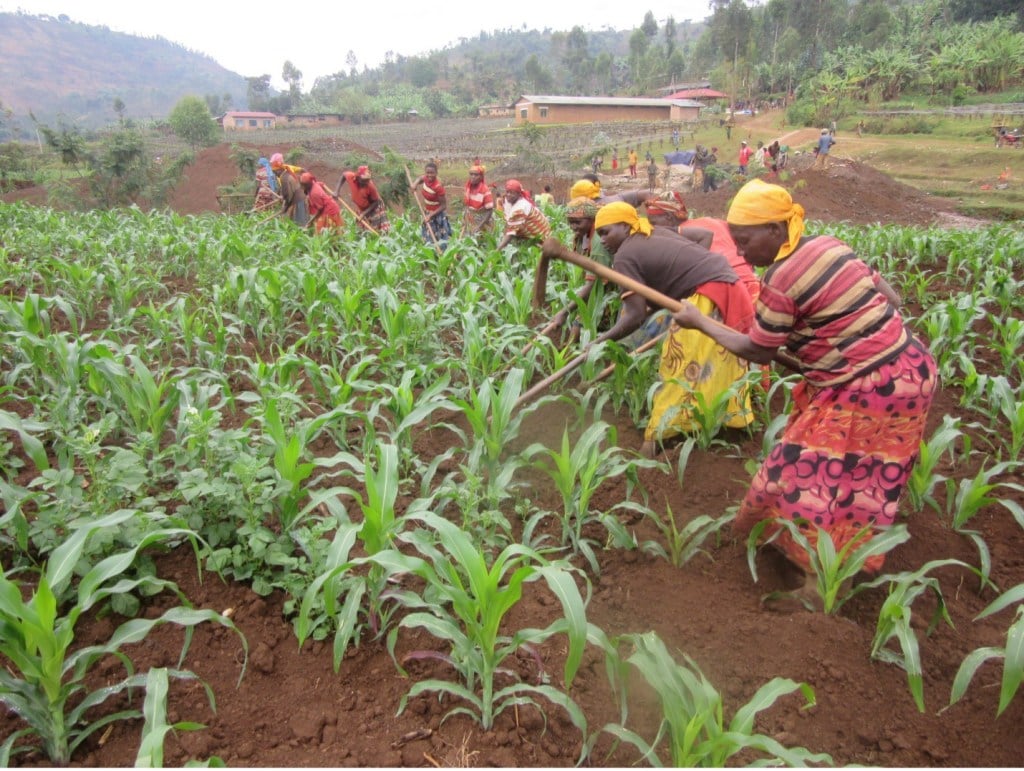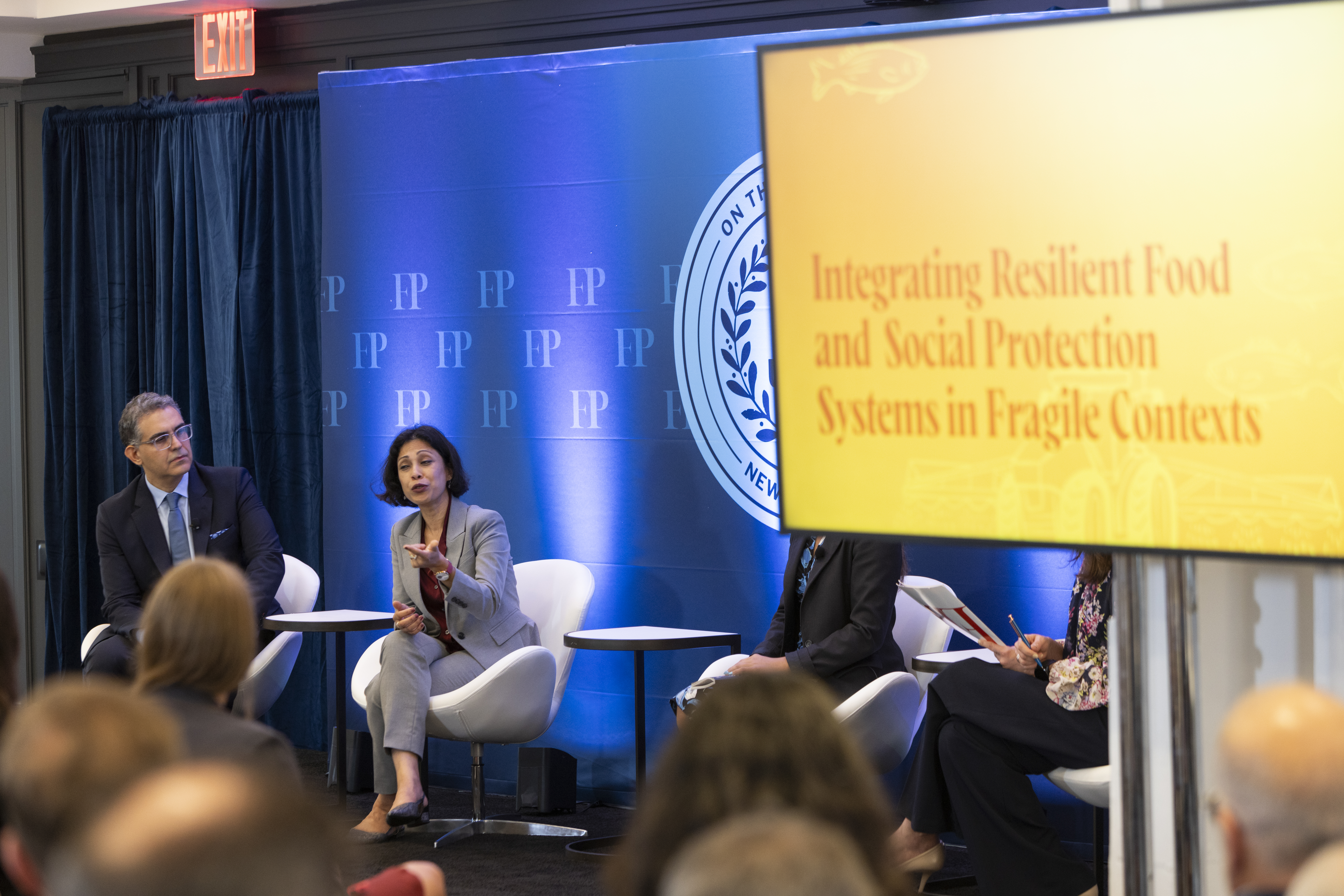Better Together: Leveraging Social Protection and Food Systems in Fragile Contexts
New pathways for resilience and jobs creation in hard places

By Iffath A. Sharif, Global Director, Social Protection and Labor, World Bank and Jonathan Papoulidis, Vice President, Food for the Hungry, Non-Resident Fellow, Center on International Cooperation, New York University
The urgency is hard to ignore. More than 294 million people face high levels of food insecurity, the highest level recorded, according to the 2025 Global Report on Food Crises. Conflict and insecurity are the single largest drivers, compounded by disasters, disease outbreaks and economic shocks. By 2030, almost 60% of the world’s poor will live in countries classified as fragile and conflict-affected situations (FCS).
Yet, despite this and mounting evidence of the long-term returns to system-based, resilience investment in fragile contexts, international assistance to fragile contexts is at a two-decade low. The support that is available is often too fragmented, short-term, and project-based to make substantial progress on national priorities and global goals. Building resilience in fragile settings means moving beyond siloed efforts toward coordinated, systems-level approaches that strengthen national and local capacities and institutions to deliver scalable, sustainable, and lasting impact.
While many countries have some form of social protection, coverage and quality varies widely, especially in low and middle-income countries where 2 billion people lack adequate coverage, with the majority of these lacking any coverage at all. Filling the coverage gap is critical—and possible—in crisis contexts. Evidence shows that social protection systems can function, and even outperform humanitarian aid, in crisis. Countries as diverse as Armenia, Burkina Faso, Ethiopia, Fiji, Kenya, Nepal, Niger, the Philippines, Somalia, Sudan, Turkey, and Yemen have shown that, when these systems are well-designed and flexible, they remain functional in crises and can even adapt to reach more people when it matters most.
At last year’s UN General Assembly meetings, we joined a Foreign Policy Food+ Forum panel to explore how integrated approaches – linking social protection and food systems – can help fragile states move from crisis to resilience and stability. With shrinking international aid, the takeaways and recommendations from that conversation feel important to bring forward today.
Leveraging resilient social protection and food systems
The potential for synergy between food systems and social protection is immense. Food systems improve nutrition, strengthen local markets, and create employment. Social protection platforms are entry points for coordinated service delivery to layer these services in a way that also promotes people’s earnings and self-reliance.
In fragile contexts, food systems are the backbone of daily life: feeding communities, generating jobs, and sustaining livelihoods. Food systems are complex networks—spanning production, processing, distribution, and consumption—and they rest on a foundation of social, institutional, and environmental conditions. These systems not only support nutrition, health, food security and livelihoods, but also contribute to GDP, fiscal resources, and the tax base. In many low-income countries, especially across rural areas, economic transformation has historically been driven by agriculture-based food systems.
Unfortunately, food systems are often the first to be significantly disrupted by conflicts, disasters, and economic shocks. Effective resilience requires a broad lens. Human capital, infrastructure, land access, regulatory frameworks, and even social norms all play a role.
A similar systems approach is needed for social protection in fragile settings. A systems approach means supporting national policies, systems, and implementation, wherever possible, in coordination with humanitarian responses. A holistic approach builds on cash assistance or in-kind support, layering insurance mechanisms and labor programs that help protect livelihoods and facilitate more and better jobs.
By aligning investments and policies across both systems, governments and partners can better respond to shocks, promote inclusive economic growth, and ensure that people are not only protected in times of crisis but also empowered to thrive in the long term.

A shared resilience framework
To leverage both food and social protection systems, a resilience framework can guide coordinated action, looking at three foundational capacities that cut across sectors and have a strong focus on sustainable outcomes and job creation.
- Absorptive capacities — to prevent, mitigate, and withstand shocks and stress.
- Adaptive capacities — to establish multiple pathways to achieving development functions and outcomes in case one pathway is disrupted by crisis.
- Transformative capacities — to create formal, scalable solutions for resilience, to convert risks into opportunities, and to address the root causes of fragility that drive risks and vulnerabilities.
Absorptive capacities
A resilient food system must be able to prevent, mitigate, and absorb a range of shocks and stress. Social protection solutions can support these functions. For instance, jobs created through cash for work programs can help build a more resilient infrastructure, from production and distribution to consumption and waste management. This includes all-weather roads, bridges, embankments, warehouses and evacuation shelters for farmers and livestock. It can procure food, create distribution mechanisms and boost consumption to prevent or reduce malnutrition through school feedings and nutritional services for women, children and vulnerable populations. Insurance products can mitigate potential disaster losses through parametric insurance, and real losses through post-disaster insurance, protecting households, jobs, assets and critical infrastructure across the value chain.
Social protection measures like these build absorptive capacities within food systems while strengthening the social protection system through larger caseloads and institutionalized delivery mechanisms for products and services. These efforts supplement food system measures for resilience, such as farmer managed natural regeneration, climate-resistant seeds and inter-cropping techniques to improve soil quality, water retention and harvests during droughts and floods.
Adaptive capacities
Food systems that have diverse production markets, value chains, trade partners and consumer bases can better adapt to shocks because they can pivot in response to disruptions and continue operating effectively. During recurring periods of drought and instability in Ethiopia’s Amhara region over the past two years, Food for the Hungry’s resilient food security activity, called PReSERVE, led on behalf of the US government, supported multiple varieties of crops, jobs, and value chains across the region. Strengthened adaptive capacity enables communities and businesses to shift from disrupted crops and value chains to alternative sources of food and income.
Adaptive social protection, as pioneered by the World Bank, has also played a vital role in supporting adaptiveness in food systems. It can support job creation, skilling and resilience training across the food system, including planning and support for adaptive capacities. Adaptive social protection can also rapidly channel social assistance to diverse workforces within the food system who are affected by crises, as well as consumer bases and communities to help smoothen consumption needs and avoid negative coping strategies like selling assets and skipping meals.
Transformative capacities
The rapid pace of digitalization and technological innovation offers a powerful opportunity to transform food and social protection systems. Digital tools can enable more targeted, inclusive, transparent, and agile responses—supporting businesses, workers, and vulnerable populations during periods of crisis and instability. They also help expand access to financing and strengthen domestic resource mobilization. Yet, the degree to which these investments can result in inclusion, transparency, and the redistribution of financing and fiscal resources will depend on the country’s political economy. Food and social protection systems are invariably part of political economies, connected to the allocation of land and property rights, large-scale cash transfers, jobs and assets, taxation, government appointments in key ministries and agencies, and the distribution of licenses and permits.
Unlike approaches that aim to restore the status quo after shocks occur, building resilience means addressing root causes of risk—such as marginalization, clientelism, and elite capture—through reforms that open space for broader participation and inclusion. For instance, there have been considerable efforts to widen the inclusion of women, youth, small holder farmers and other marginalized groups within food systems.
Next steps
This is a pivotal moment to strengthen resilience in fragile contexts by better leveraging the combined potential of food systems and social protection, fostering pathways for job creation, long-term growth, and lasting stability.
To scale these efforts, we need to build on proven solutions and simplify our approach. Across both food systems and social protection systems, there exist global partnerships that we can bolster and bring together to align leadership, expertise, financing, and implementation across sectors and stakeholders. For example, the Global Alliance Against Hunger and Poverty provides high-level leadership and resources at the intersection of food systems and food-sensitive social protection, particularly through its evolving policy basket. By uniting government, civil society, donors, and private partners around a shared resilience framework and comprehensive and effective support to large-scale, well designed, country-led systems and programs, this platform could unlock the full potential of these systems to deliver jobs, food security, and essential services in fragile settings.
The World Bank would be well placed to lead this effort. In the past year, it supported national programs reaching 222 million people, including 75 million in fragile contexts, with social protection coverage. With support from Norway and Japan, it also launched a renewed effort to scale innovation in food-sensitive social protection in 25 countries. Working alongside partners, it has committed to reach 500 million more people, half being women, with social protection coverage by 2030.
Organizations like Food for the Hungry—through its integrated, resilient systems model spanning food, health, education, and water—bring valuable experience and can play a key role in advancing this agenda. A coordinated platform could push this momentum forward, channel financing more effectively, and ensure country demands are met with practical solutions.
In the Chair’s Statement of the 111th Meeting of the World Bank Development Committee, Sweden’s Minister of Finance Elisabeth Svantesson emphasized investing in the building blocks of resilience – including jobs and skills, food and nutrition– without which stabilized economies and livelihoods are unlikely to take root.
When working together, social protection systems and food systems can create a transformative path to tackle the structural drivers of fragility and create lasting change.
